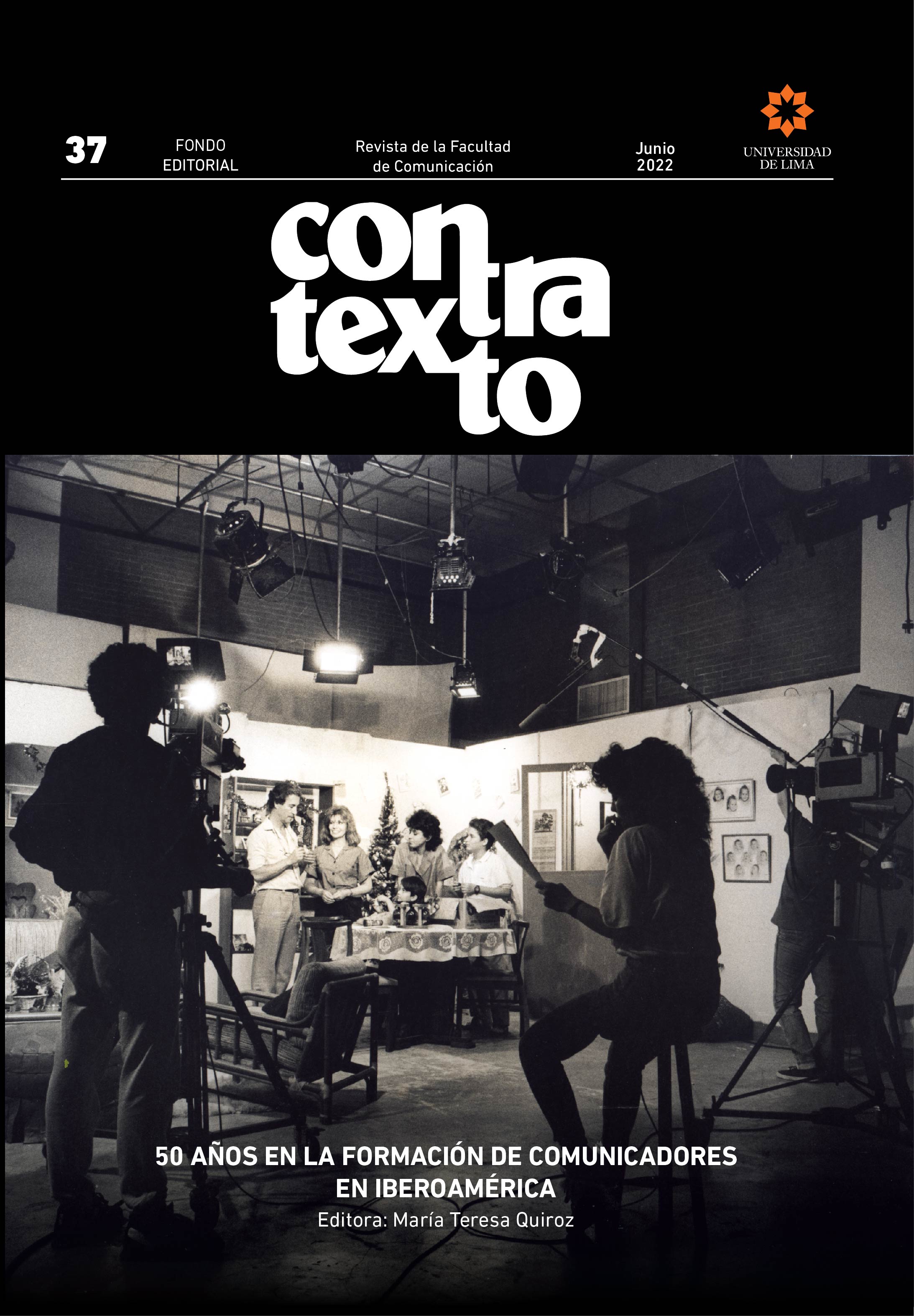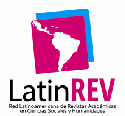Características de la desinformación en redes sociales. Estudio comparado de los engaños desmentidos en Argentina y España durante el 2020
DOI:
https://doi.org/10.26439/contratexto2022.n037.5343Palabras clave:
desinformación, polarización, populismo, Argentina, EspañaResumen
Este trabajo estudia los principales rasgos de las desinformaciones que circularon en redes sociales en Argentina y España durante el año 2020, así como sus similitudes y diferencias. La investigación aplica un análisis de contenido de siete variables a 402 engaños desmentidos en ambos países por los medios verificadores Chequeado y Newtral. En concreto, se estudian las fuentes de las desinformaciones, su tipología, los protagonistas y sus atributos, su adscripción temática, las emociones a las que apelan y los rasgos populistas que presentan. Los resultados evidencian el predominio de (a) fuentes anónimas en ambos países, de fuentes reales mediáticas en Argentina y de fuentes políticas suplantadas en España; (b) el engaño como forma de desinformación; (c) la clase política como protagonista, casi siempre con una transmisión de atributos negativos; (d) la salud como tema principal, aspecto derivado de la pandemia del COVID-19, seguido por la calidad de la democracia, en Argentina, y por el consumo y cuestiones políticas personales, en España; (e) la apelación a emociones negativas, especialmente la ira y el miedo, propias de la polarización afectiva negativa; y (f) el ataque a las élites y la defensa de los intereses de la ciudadanía como rasgos discursivos populistas.
Descargas
Referencias
Aruguete, N., & Calvo, E. (2018). Time to #protest: selective exposure, cascading activation, and framing in social media. Journal of Communication, 68(3), 480-502. https://doi.org/10.1093/joc/jqy007
Bennett, W. L., & Livingston, S. (2018). The disinformation order: disruptive communication and the decline of democratic institutions. European Journal of Communication, 33(2), 122-139. https://doi.org/doi:10.1177/0267323118760317
Bergmann, E. (2020). Populism and the politics of misinformation. Safundi. The Journal of South African and American Studies, 21(3), 251-265. https://doi.org/10.1080/17533171.2020.1783086
Brader, T. (2006). Campaigning for hearts and minds. How emotional appeals in political ads work. University of Chicago Press.
Calvo, D., Campos-Domínguez, E., & Díez-Garrido, M. (2019). Hacia una campaña computacional: herramientas y estrategias online en las elecciones españolas. Revista Española de Ciencia Política, 51, 123-154. https://doi.org/10.21308/recp.51.05
Calvo, E., & Aruguete, N. (2018). #Tarifazo. Medios tradicionales y fusión de agenda en redes sociales. Inmediaciones de la Comunicación, 13(1), 189-213. https://doi.org/10.18861/ic.2018.13.1.2831
Casero-Ripollés, A. (2018). Research on political information and social media: key points and challenges for the future. El Profesional de la Información, 27(5), 964-974. https://doi.org/10.3145/epi.2018.sep.01
Castells, M. (2009). Comunicación y poder. Alianza Editorial.
Chadwick, A., & Vaccari, C. (2019). News sharing on UK social media: misinformation, disinformation & correction. Loughborough University, Online Civic Culture Centre. https://hdl.handle.net/2134/37720
Damasio, A. (2001). Fundamental feelings. Nature, 413(6858), 781. http://doi.org/10.1038/35101669
Engesser, S., Fawzi, N., & Larsson, A. O. (2017). Populist online communication: introduction to the special issue. Information, Communication & Society, 20(9), 1279-1292. https://doi.org/10.1080/1369118X.2017.1328525
Esser, F., & Pfetsch, B. (2020). Comparing political communication: a 2020 update. En D. Caramani (Ed.), Comparative politics (5.ª ed., pp. 336-358). Oxford University Press. https://doi.org/10.5167/uzh-186963
Faris, R. M., Roberts, H., Etling, B., Bourassa, N., Zuckerman, E., & Benkler, Y. (2017). Partisanship, propaganda, and disinformation: online media and the 2016 U. S. Presidential Election. Berkman Klein Center for Internet & Society. http://nrs.harvard.edu/urn-3:HUL.InstRepos:33759251
Freelon, D., Marwick, A., & Kreiss, D. (2020). False equivalencies: online activism from left to right. Science, 369(6508), 1197-1201. https://doi.org/10.1126/SCIENCE.ABB2428
Gamir-Ríos, J., Tarullo, R., & Ibáñez-Cuquerella, M. (2021). Multimodal disinformation about otherness on the internet: the spread of racist, xenophobic and Islamophobic fake news in 2020. Anàlisi: Quaderns de Comunicació i Cultura, 64, 49-64. https://doi.org/10.5565/rev/analisi.3398
Gil de Zúñiga, H., Brian Weeks, C., & Ardèvol-Abreu, A. (2017). Effects of the news-finds me perception in communication: social media use implications for news seeking and learning about politics. Journal of Computer-Mediated Communication, 22, 105-123. https://doi.org/10.1111/jcc4.12185
Guess, A., Nagler, J., & Tucker, J. (2019). Less than you think: prevalence and predictors of fake news dissemination on Facebook. Science Advances, 5(1), eaau4586. https://doi.org/10.1126/sciadv.aau4586
Gutiérrez-Coba, L. M., Coba-Gutiérrez, P., & Gómez-Díaz, J. A. (2020). Noticias falsas y desinformación sobre el COVID-19: análisis comparativo de seis países iberoamericanos. Revista Latina de Comunicación Social, 78, 237-264. https://www.doi.org/10.4185/RLCS-2020-1476
Handlin, S. (2018). The logic of polarizing populism: state crises and polarization in South America. American Behavioral Scientist, 62(1), 75-91. https://doi.org/10.1177/0002764218756922
Helmond, A. (2015). The platformization of the web: making web data platform ready. Social Media + Society, 1(2), 1-11. https://doi.org/10.1177/2056305115603080
Humanes, M. L. (2019). Selective exposure in a changing political and media environment. Media and Communication, 7(3), 1-3. https://doi.org/10.17645/mac.v7i3.2351 Igartua, J. J. (2006). Métodos cuantitativos de investigación en Comunicación. Bosch.
Innerarity, D., & Colomina, C. (2020). La verdad en las democracias algorítmicas. Revista CIDOB d’Afers Internacionals, 124, 11-24. https://doi.org/10.24241/rcai.2020.124.1.11
Iyengar, S., Sood, G., & Lelkes, Y. (2012). Affect, not ideology: a social identity perspective on polarization. Public Opinion Quarterly, 76(3), 405-431. https://doi.org/10.1093/poq/nfs038
Jerit, J. (2004). Survival of the fittest: rethoric during the course of an election campaign. Political Psicology, 25, 563-575. https://www.jstor.org/stable/3792409
Kemp, S. (2021). Digital 2021: Global Overview report. DATAREPORTAL. https://datareportal.com/reports/digital-2021-global-overview-report
Kosloff, S., Greenberg, J., Schmader, T., Dechesne, M., & Weise, D. (2010). Smearing the opposition: implicit and explicit stigmatization of the 2008 U. S. Presidential candidates and the current U. S. President. Journal of Experimental Psychology: General, 139(3), 383-398. https://doi.org/https://doi.org/10.1037/a0018809
Lakoff, G. (2007). No pienses en un elefante. Lenguaje y debate político. Editorial Complutense
Lazer, D. M. J., Baum, M. A., Benkler, Y., Berinsky, A. J., Greenhill, K. M., Menczer, F., Metzger, M. J., Nyhan, B., Pennycook, G., Rothschild, D., Schudson, M., Sloman, S. A., Sunstein, C. R., Thorson, E. A., Watts, D. J., & Zittrain, J. L. (2018). The science of fake news. Science, 359(6380), 1094-1096. https://doi.org/10.1126/science.aao2998
López-Borrull, A., & Ollé, C. (2020). Curación de contenidos científicos en tiempos de fake science y COVID-19: una aproximación entre las ciencias de la información y la comunicación. En Comunicación y diversidad. Selección de comunicaciones del VII Congreso Internacional de la Asociación Española de Investigación de la Comunicación (AE-IC) (pp. 281-289). https://doi.org/10.3145/ae-ic-epi.2020.e16
López-López, P. C., Castro Martínez, P., & Oñate, P. (2020). Agenda melding y teorías de la comunicación: la construcción de la imagen. Cuadernos del Centro de Estudios en Diseño y Comunicación, 112, 21-34. https://doi.org/10.18682/cdc.vi112.4089
Magallón-Rosa, R., & Sánchez-Duarte, J. M. (2021). Verificación informativa durante la COVID-19: análisis comparativo en los países del sur de Europa. Janus.Net, Dossiê Temático Relações Internacionais e Redes Sociais, 152-165. https://doi.org/10.26619/1647-7251.DT21.10
Manfredi-Sánchez, J., Amado, A., & Waisbord, S. (2021). Presidential Twitter in the face of COVID-19: between populism and pop politics. Comunicar, XXIX(66), 83-94. https://doi.org/https://doi.org/10.3916/C66-2021-07
Marwick, A., & Lewis, R. (2017). Media manipulation and disinformation online. Data & Society Research Institute. https://datasociety.net/library/media-manipulation-and-disinfo-online/
Mazzoleni, G. (2010). La comunicación política. Alianza Editorial
Morgan, S. (2018). Fake news, disinformation, manipulation and online tactics to undermine democracy. Journal of Cyber Policy, 3(1), 39-43. https://doi.org/10.1080/23738871.2018.1462395
Mourão, R. R., & Robertson, C. T. (2019). Fake news as discursive integration: an analysis of sites that publish false, misleading, hyperpartisan and sensational information. Journalism Studies, 20(14), 2077-2095. https://doi.org/10.1080/1461670X.2019.1566871
Mudde, C., & Rovira Kaltwasser, C. (2017). Populism. A very short introduction. Oxford University Press.
Nai, A. (2018). Fear and loathing in populist campaigns? Comparing the communication style of populists and non-populists in elections worldwide. Journal of Political Marketing, 20(2), 219-250. https://doi.org/10.1080/15377857.2018.1491439
Newman, N., Fletcher, R., Schulz, A., Andı, S., & Nielsen, R. K. (2020). Reuters Institute Digital News Report 2020. https://reutersinstitute.politics.ox.ac.uk/sites/default/files/2020-06/DNR_2020_FINAL.pdf
Nielsen, R. K., Fletcher, R., Newman, N., Brennen, J. S., & Howard, P. N. (2020). Navigating the “infodemic”: how people in six countries access and rate news and information about coronavirus. Misinformation, Science, and Media, (April), 1-34. https://reutersinstitute.politics.ox.ac.uk/sites/default/files/2020-04/Navigating%20the%20Coronavirus%20Infodemic%20FINAL.pdf
Pariser, E. (2017). El filtro burbuja. Cómo la web decide lo que leemos y lo que pensamos. Taurus.
Peña Ascacíbar, G., Bermejo Malumbres, E., & Zanni, S. (2021). Fact checking durante la COVID-19: análisis comparativo de la verificación de contenidos falsos en España e Italia. Revista de Comunicación, 20(1), 197-215. https://doi.org/10.26441/rc20.1-2021-a11
Rodríguez, C. P., Carballido, B. V., Redondo-Sama, G., Guo, M., Ramis, M., & Flecha, R. (2020). False news around COVID-19 circulated less on Sina Weibo than on Twitter: how to overcome false information? International and Multidisciplinary Journal of Social Sciences, 9(2), 107-128. https://doi.org/10.17583/RIMCIS.2020.5386
Roemmele, A., & Gibson, R. (2020). Scientific and subversive: the two faces of the fourth era of political campaigning. New Media & Society, 22(4), 595-610. https://doi.org/10.1177/1461444819893979
Salaverría, R., Buslón, N., López-Pan, F., León, B., López-Goñi, I., & Erviti, M.-C. (2020). Desinformación en tiempos de pandemia: tipología de los bulos sobre la COVID 19. El Profesional de la Información, 29(3), 1-15. https://doi.org/10.3145/epi.2020.may.15
Semetko, H. A., & Tworzecki, H. (2017). Campaign strategies, media, and voters: the fourth era of political communication. En J. Fisher, E. Fieldhouse, M. N. Franklin, R. Gibson, M. Cantijoch & C. Wlezien (Eds.), The Routledge Handbook of Elections, Voting Behavior and Public Opinion (pp. 293-304). Routledge.
Seo, H., & Faris, R. (2021). Comparative approaches to mis/disinformation. International Journal of Communication, 15, 1165-1172. https://ijoc.org/index.php/ijoc/article/view/14799/3376
Sivak, M. (2015). Clarín. La era Magnetto. Planeta.
Suhay, E., Bello-Pardo, E., & Maurer, B. (2018). The polarizing effects of online partisan criticism: evidence from two experiments. The International Journal of Press/Politics, 23, 195-115. https://doi.org/10.1177/1940161217740697
Sunstein, C. (2007). Republic.com 2.0. Princeton University Press. https://catalog.princeton.edu/catalog/9985551303506421
Tarullo, R. (2016). Esperanza y miedo: una aproximación teórica a las emociones en la comunicación política. Dixit. Revista de Comunicación, 25, 28-37. https://doi.org/10.22235/d.v0i25.1271
Tarullo, R. (2018). La emoción en la comunicación política en Facebook: un análisis de los mensajes publicados en Facebook por los dirigentes políticos argentinos. Austral Comunicación, 7(1), 27-55. https://doi.org/10.26422/aucom.2018.0701.tar
Tarullo, R., & Frezzotti, Y. (2021). Ver no siempre es creer: el uso juvenil de Instagram como canal de información y noticias falsas sobre COVID-19. Cuaderno, 136, 37-53.
Tucker, J. A., Guess, A., Barberá, P., Vaccari, C., Siegel, A., Sanovich, S., Stukal, D., & Nyhan, B. (2018). Social media, political polarization, and political disinformation: a review of the scientific literature. William and Flora Hewlett Foundation. https://doi.org/10.2139/ssrn.3144139
Vosoughi, S., Roy, D., & Aral, S. (2018). The spread of true and false news online. Science, 359(6380), 1146-1151. https://doi.org/10.1126/science.aap9559
Waisbord, S. (2015). United and fragmented: communication and media studies in Latin America. Journal of Latin American Communication Research, 4(1), 55-77.
Waisbord, S. (2018). The elective affinity between post-truth communication and populist politics. Communication Research and Practice, 4(1), 17-34. DOI: 10.1080/22041451.2018.1428928
Waisbord, S. (2020). ¿Es válido atribuir la polarización política a la comunicación digital? Sobre burbujas, plataformas y polarización afectiva. Revista SAAP, 14(2), 249-279. https://doi.org/10.46468/rsaap.14.2.A1
Wardle, C., & Derakhshan, H. (2017). Information disorder. Toward an interdisciplinary framework for research and policymaking. Council of Europe. https://rm.coe.int/information-disorder-toward-an-interdisciplinary-framework-for-researc/168076277c
Weeks, B. E. (2015). Emotions, partisanship, and misperceptions: how anger and anxiety moderate the effect of partisan bias on susceptibility to political misinformation. Journal of Communication, 65, 699-719. https://doi.org/10.1111/jcom.12164
Weeks, B. E., & Garrett, R. K. (2014). Electoral consequences of political rumors: motivated reasoning, candidate rumors, and vote choice during the 2008 U. S. Presidential election. International Journal of Public Opinion Research, 26(4), 401-422. https://doi.org/10.1093/IJPOR/EDU005
Zarocostas, J. (2020). How to fight an infodemic. The Lancet, 395(10225), 676. https://doi.org/10.1016/S0140-6736(20)30461-X
Zunino, E. (2021). Medios digitales y COVID-19: sobreinformación, polarización y desinformación. Universitas, 34, 133-153. https://doi.org/10.17163/uni.n34.2021.06
Publicado
Número
Sección
Licencia
Todos los trabajos publicados están sujetos a una licencia CC BY 4.0 Creative Commons (actualizado el 1 de marzo de 2021).
El contenido de la revista se puede compartir en cualquier material o formato. Asimismo, se puede adaptar, contribuir y transformar. Ambas posibilidades sólo están permitidas en la medida en que cumplan las siguientes condiciones:
- Atribución: Se debe otorgar crédito donde sea debido, proporcionar un enlace a la licencia e indicar los cambios en caso se realice alguno. Esto debe hacerse de la manera que se considere apropiada, sin sugerir que el licenciante lo promueva a usted o su uso del material.
Derechos de propiedad
Los derechos patrimoniales de Contratexto se publican bajo una licencia Creative Commons BY 4.0, lo que permite a los autores mantener los derechos patrimoniales de su obra sin restricciones.
Si un trabajo publicado en Contratexto fuera copiado, distribuido, difundido o cualquier otra actividad contemplada en la licencia antes mencionada, se deberá mencionar de manera visible y expresa al autor o autores y a la revista.
Auto-archivo
Esta revista permite y anima a los autores/as a publicar artículos enviados a la revista en sus sitios web personales o en depósitos institucionales, tanto antes como después de su publicación en esta revista, siempre y cuando proporcionen información bibliográfica que acredite, si procede, su publicación en ella.


















